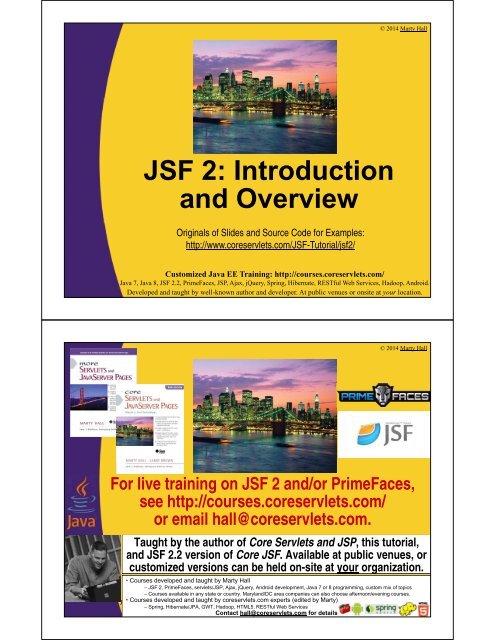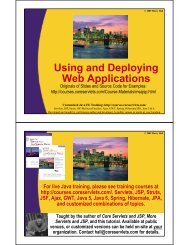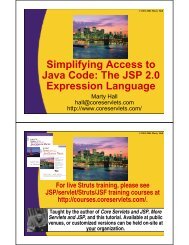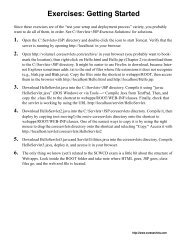JSF 2.0: Introduction and Overview - Custom Training Courses ...
JSF 2.0: Introduction and Overview - Custom Training Courses ...
JSF 2.0: Introduction and Overview - Custom Training Courses ...
You also want an ePaper? Increase the reach of your titles
YUMPU automatically turns print PDFs into web optimized ePapers that Google loves.
Bank Account Balances:Servlet Code14public class ShowBalance extends HttpServlet {public void doGet(HttpServletRequest request,HttpServletResponse response)throws ServletException, IOException {Bank<strong>Custom</strong>er current<strong>Custom</strong>er =Bank<strong>Custom</strong>erLookup.get<strong>Custom</strong>er(request.getParameter("id"));request.setAttribute("customer", current<strong>Custom</strong>er);String address;if (current<strong>Custom</strong>er == null) {address ="/WEB-INF/bank-account/Unknown<strong>Custom</strong>er.jsp";} else if (current<strong>Custom</strong>er.getBalance() < 0) {address ="/WEB-INF/bank-account/NegativeBalance.jsp";} ...RequestDispatcher dispatcher =request.getRequestDispatcher(address);dispatcher.forward(request, response);Bank Account Balances:Beanpublic class Bank<strong>Custom</strong>er {private final String id, firstName, lastName;private final double balance;public Bank<strong>Custom</strong>er(String id,String firstName,String lastName,double balance) {this.id = id;this.firstName = firstName;this.lastName = lastName;this.balance = balance;}// Getters for four instance variables. No setters.15}public double getBalanceNoSign() {return(Math.abs(balance));}
Bank Account Balances:Business Logicpublic class Bank<strong>Custom</strong>erLookup {private static Map customers;static {// Populate Map with some sample customers}…}public static Bank<strong>Custom</strong>er get<strong>Custom</strong>er(String id) {return(customers.get(id));}16Bank Account Balances:Input Form…Bank Account Balance<strong>Custom</strong>er ID: …For the servlet, use the address http://host/appName/show-balance that is set via url-pattern in web.xml17
Bank Account Balances:JSP Code (Negative Balance)…We Know Where You Live!Watch out, ${customer.firstName},we know where you live.Pay us the $${customer.balanceNoSign}you owe us before it is too late!18Bank Account Balances:web.xmlShowBalancecoreservlets.ShowBalanceShowBalance/show-balance...19
Bank Account Balances:Results20Advantages of <strong>JSF</strong> (vs. MVC UsingRequestDispatcher)21• <strong>Custom</strong> GUI controls– <strong>JSF</strong> provides a set of APIs <strong>and</strong> associated custom tags to create HTMLforms that have complex interfaces• There are many extra-rich third-party <strong>JSF</strong> libraries• Event h<strong>and</strong>ling– <strong>JSF</strong> makes it easy to designate Java code that is invoked when forms aresubmitted. The code can respond to particular buttons, changes inparticular values, certain user selections, <strong>and</strong> so on.• Managed beans– In JSP, you can use property="*" with jsp:setProperty to automaticallypopulate a bean based on request parameters. <strong>JSF</strong> extends this capability<strong>and</strong> adds in several utilities, all of which serve to greatly simplify requestparam processing.• Integrated Ajax support– You can use jQuery, Dojo, or Ext-JS with servlets <strong>and</strong> JSP. However, <strong>JSF</strong>lets you use Ajax without explicit JavaScript programming <strong>and</strong> with verysimple tags. Also, the Ajax calls know about the server-side business logic.
22Advantages of <strong>JSF</strong> (vs.St<strong>and</strong>ard MVC), Continued• Form field conversion <strong>and</strong> validation– <strong>JSF</strong> has builtin capabilities for checking that form values are in therequired format <strong>and</strong> for converting from strings to various other data types.If values are missing or in an improper format, the form can beautomatically redisplayed with error messages <strong>and</strong> with the previouslyentered values maintained.• Page templating– Although JSP has jsp:include for reuse of content, <strong>JSF</strong> has a full-fledgedpage templating system that lets you build pages that share layout orcontent• Centralized file-based configuration– Rather then hard-coding information into Java programs, many <strong>JSF</strong> valuesare represented in XML or property files. This loose coupling means thatmany changes can be made without modifying or recompiling Java code,<strong>and</strong> that wholesale changes can be made by editing a single file. Thisapproach also lets Java <strong>and</strong> Web developers focus on their specific taskswithout needing to know about the overall system layout.• Consistent approach– <strong>JSF</strong> encourages consistent use of MVC throughout your application.23Disadvantages of <strong>JSF</strong> (vs. MVCwith RequestDispatcher)• Bigger learning curve– To use MVC with the st<strong>and</strong>ard RequestDispatcher, youneed to be comfortable with the st<strong>and</strong>ard JSP <strong>and</strong> servletAPIs. To use MVC with <strong>JSF</strong>, you have to be comfortablewith the servlet API <strong>and</strong> a large <strong>and</strong> elaborate frameworkthat is almost equal in size to the core system.– Similarly, if you have an existing app <strong>and</strong> want to add insome small amounts of Ajax functionality, it ismoderately easy with jQuery (quite easy if you knowJavaScript already). Switching your app to <strong>JSF</strong> 2 is a biginvestment.• Worse documentation– Compared to the st<strong>and</strong>ard servlet <strong>and</strong> JSP APIs, <strong>JSF</strong> hasfewer online resources, <strong>and</strong> many first-time users find theonline <strong>JSF</strong> documentation confusing <strong>and</strong> poorlyorganized. True for both Mojarra <strong>and</strong> MyFaces.
Disadvantages of <strong>JSF</strong> (vs.St<strong>and</strong>ard MVC), Continued• Less transparent– With <strong>JSF</strong> applications, there is a lot more going onbehind the scenes than with normal Java-based Webapplications. As a result, <strong>JSF</strong> applications are:• Harder to underst<strong>and</strong>• Harder to benchmark <strong>and</strong> optimize• Rigid approach– The flip side of the benefit that <strong>JSF</strong> encourages aconsistent approach to MVC is that <strong>JSF</strong> makes it difficultto use other approaches.24© 2014 Marty Hall<strong>JSF</strong> 2 vs. Struts 2<strong>Custom</strong>ized Java EE <strong>Training</strong>: http://courses.coreservlets.com/Java 7, Java 8, <strong>JSF</strong> 2.2, PrimeFaces, JSP, Ajax, jQuery, Spring, Hibernate, RESTful Web Services, Hadoop, Android.Developed <strong>and</strong> taught by well-known author <strong>and</strong> developer. At public venues or onsite at your location.
Struts is a Serious Alternative26• Situation– You decide that for your application, the benefits (power)of using a Web application framework [vs. servlets/JSPwith MVC] outweigh the disadvantages (complexity)• Problem– <strong>JSF</strong> is not the only game in town• Alternatives– Struts is the most popular alternative to <strong>JSF</strong>– But there are many more• Spring MVC• Apache Wicket• Apache Tapestry• jMaki• …27Advantages of <strong>JSF</strong>(vs. Struts)• <strong>Custom</strong> components– <strong>JSF</strong> makes it relatively easy to combine complex GUIs into a singlemanageable component; Struts does not– There are many existing third-party component libraries for <strong>JSF</strong>,virtually none for Struts• PrimeFaces, JBoss RichFaces, Oracle ADF, IceFaces, ApacheTomahawk, Woodstock, Web Galileo, …• Support for other display technologies– <strong>JSF</strong> is not limited to HTML <strong>and</strong> HTTP; Struts is• Access to beans by name– <strong>JSF</strong> lets you assign names to beans, then you refer to them by namein the forms. Struts has a complex process with several levels ofindirection.• Official part of Java EE– <strong>JSF</strong> is part of the Java EE spec, <strong>and</strong> all servers that support Java EEinclude <strong>JSF</strong> (<strong>JSF</strong> 2 is part of Java EE 6)
<strong>JSF</strong> <strong>Custom</strong> Components:Examples2829Advantages of <strong>JSF</strong>(vs. Struts), Continued• Expression language– The <strong>JSF</strong> expression language is more concise <strong>and</strong> powerfulthan the Struts bean:write tag.• This is less advantageous vs. Struts 2• Simpler controller <strong>and</strong> bean definitions– <strong>JSF</strong> does not require your controller <strong>and</strong> bean classes to extendany particular parent class (e.g., Action) or use any particularmethod (e.g., execute). Struts does.• Simpler config file <strong>and</strong> overall structure– The faces-config.xml file is much easier to use than is thestruts-config.xml file. In general, <strong>JSF</strong> is simpler.• Better tool support– As of mid-2011, both Eclipse <strong>and</strong> NetBeans have moderatelygood integrated support for <strong>JSF</strong> 2• But still not as good as the <strong>JSF</strong> 1 support in the now-extinct SunJava Studio Creator
Disadvantages of <strong>JSF</strong>(vs. Struts)• Established base30Counter-Arguments reEstablished Base• Trends/momentum31
Counter-Arguments reEstablished Base• Google Trends vs. Indeed.com job listings32Disadvantages of <strong>JSF</strong> (vs. Struts),Continued• Support for other display technologies– <strong>JSF</strong> is not limited to HTML <strong>and</strong> HTTP; Struts is• Hey! Didn't I say this was an advantage of <strong>JSF</strong>?• Confusion vs. file names– The actual pages used in <strong>JSF</strong> end in .xhtml. But the URLs usedend in .faces or .jsf. This causes many problems.• You cannot browse directories <strong>and</strong> click on links• It is hard to protect raw XHTML pages from access• It is hard to refer to non-faces pages in faces-config.xml• Self-submit approach– With Struts, the form (blah.jsp) <strong>and</strong> the h<strong>and</strong>ler (blah.do)havedifferent URLs; with <strong>JSF</strong> they are the same (blah.jsf).33
Disadvantages of <strong>JSF</strong> (vs.Struts), Continued• Much weaker automatic validation– Struts comes with form-field validators for email address,credit card numbers, regular expressions, <strong>and</strong> more. <strong>JSF</strong>only comes with validators for missing values, length ofinput, <strong>and</strong> numbers in a given range.• You can use third-party validation libraries with <strong>JSF</strong> (e.g.,MyFaces/Tomahawk built on the Struts/Commonsvalidation library), but still not as powerful as Struts• Lack of client-side validation– Struts supports JavaScript-based form-field validation;<strong>JSF</strong> does not• You can use Ajax-based validation in <strong>JSF</strong>, but still not asgood as the true client-side validation in Struts34© 2014 Marty Hall<strong>JSF</strong> 2 vs.Other Ajax Approaches<strong>Custom</strong>ized Java EE <strong>Training</strong>: http://courses.coreservlets.com/Java 7, Java 8, <strong>JSF</strong> 2.2, PrimeFaces, JSP, Ajax, jQuery, Spring, Hibernate, RESTful Web Services, Hadoop, Android.Developed <strong>and</strong> taught by well-known author <strong>and</strong> developer. At public venues or onsite at your location.
Three Main Options36• Traditional JavaScript library– Add JavaScript code to your existing Web app to addricher GUIs <strong>and</strong> to support asynchronous, incrementalupdates to your page• E.g., jQuery, Dojo, Ext-JS, YUI, Prototype/Scriptaculous,Google Closure, Mootools• GWT– Write everything in Java. Use RPC mechanism to talk toserver. Client-side code gets compiled to JavaScript.• <strong>JSF</strong> 2 (or another framework with integratedAjax support)– Use simple tags to perform Ajax requests, withoutexplicit JavaScript programming37Using a Traditional JavaScriptLibrary• Scenario– You already built a Web app (using Java, .NET, PHP,Ruby on Rails, or whatever)– You want to upgrade it by adding richer GUI elements<strong>and</strong> Ajax-enabled features– You do not want to start over <strong>and</strong> reimplement theexisting functionality• Best approach– Use JavaScript library with rich widgets <strong>and</strong> Ajax support• jQuery, Ext-JS, Dojo, YUI, Prototype/Scriptaculous,Google Closure, Mootools– Which library is best is another hard question• Different libraries have different strengths. I have an entiretalk on this question.
Example: jQuery for Bank<strong>Custom</strong>er Info• Functionality– Enter a customer ID– Show the first name, last name, <strong>and</strong> bank account balanceof customer with that ID– Show error message if ID does not exist• Goals– Do not reload the page– Use existing server-side logic• Approach– Use jQuery to pass ID to server via Ajax request <strong>and</strong> toinsert result into page– Extend server to format customer as list38Bank Example: HTML…Find <strong>Custom</strong>er Info<strong>Custom</strong>er ID:…39
Bank Example: JavaScript$(function() {$("#customer-button").click(show<strong>Custom</strong>er);});function show<strong>Custom</strong>er() {var queryData = $("#customer-form").serialize();$("#customer-region").load("find-customer-by-id",queryData);}40Bank Example: Java41public class Find<strong>Custom</strong>erByID extends HttpServlet {public void doGet(HttpServletRequest request,HttpServletResponse response)throws ServletException, IOException {String customerID = request.getParameter("customerID");<strong>Custom</strong>er customer =<strong>Custom</strong>erUtils.get<strong>Custom</strong>er(customerID);String customerData;if (customer == null) {customerData = ResultUtils.makeErrorMessage("ID");} else {customerData = ResultUtils.makeBulletedList(customer);}PrintWriter out = response.getWriter();out.print(customerData);}}
Bank Example: Results42Using GWT• Scenario– You are starting a new Web app– You want a large pure-Ajax app• Looks like a desktop application• Has complex client-server communication– For client-side code, you want strong typing, many datastructures, <strong>and</strong> few runtime errors• You want Java, not JavaScript for the client!• Best approach– Use the Google Web Toolkit• Client-side Java code gets compiled to JavaScript• Powerful RPC mechanism for talking to server43
44Example: GWT for Bank<strong>Custom</strong>er Info• Functionality– Enter a customer ID– Show the first name, last name, <strong>and</strong> bank account balanceof customer with that ID– Show error message if ID does not exist• Goals– Do not reload the page– Use straightforward server-side logic (no HTTP methods)– Return <strong>Custom</strong>er object, not just String, to client• Approach– Use GWT– Use <strong>Custom</strong>er class on both client <strong>and</strong> serverBank Example: Java(<strong>Custom</strong>er Class)public class <strong>Custom</strong>er implements Serializable {private String id, firstName, lastName;private double balance;}public <strong>Custom</strong>er(String id,String firstName,String lastName,double balance) {this.id = id;this.firstName = firstName;this.lastName = lastName;this.balance = balance;}…// Getters <strong>and</strong> setters45
Bank Example: Java(Core Client Code – Part 1)private class ButtonH<strong>and</strong>ler implements ClickH<strong>and</strong>ler {public void onClick(ClickEvent event) {String id = idBox.getText();serviceProxy.find<strong>Custom</strong>er(id, new ButtonCallback());}}46Bank Example: Java(Core Client Code – Part 2)private class ButtonCallback implements AsyncCallback{public void onSuccess(<strong>Custom</strong>er result) {if (result != null) {String message = result.getFirstName() + " " +result.getLastName() +" has balance of $" +result.getBalance();customerInfo.setHTML(message);} else {customerInfo.setHTML("No such ID");}}47}public void onFailure(Throwable caught) {Window.alert("Unable to get data from server.");}
Bank Example: Java(Core Server Code)public class DataServiceImpl extends RemoteServiceServletimplements DataService {public <strong>Custom</strong>er find<strong>Custom</strong>er(String id) {<strong>Custom</strong>erLookupService service =new <strong>Custom</strong>erSimpleMap();return(service.find<strong>Custom</strong>er(id));}}48Bank Example: JavaScriptThis page deliberately left blank49
Bank Example: Results50Using <strong>JSF</strong> 2• Scenario– You are starting a new Web app– You want a hybrid application• Regular form submission <strong>and</strong> page navigation• Ajax-enabled content• Richer controls– You don’t want to write a lot of JavaScript by h<strong>and</strong>• Best approach– Use a Web app framework that includes rich controls <strong>and</strong>integrated Ajax support• Java developers: <strong>JSF</strong> 2, Struts 2, or Spring MVC 3.0• .NET developers: ASP.NET Ajax51
52Example: <strong>JSF</strong> 2 for Bank<strong>Custom</strong>er Info• Functionality– Enter a customer ID– Show the first name, last name, <strong>and</strong> bank account balanceof customer with that ID– Show error message if ID does not exist• Goals– Do not reload the page– Use existing server-side logic <strong>and</strong> bean names– Use familiar <strong>JSF</strong> tags, not explicit JavaScript• Approach– Use <strong>JSF</strong> 2 tag– Leave server code unchangedBank Example: <strong>JSF</strong> (Facelets)…<strong>Custom</strong>er ID:Password:…53
Bank Example: JavaScriptThis page deliberately left blank54Bank Example: Java@ManagedBeanpublic class BankingBeanAjax extends BankingBeanBase {private String message = "";public String getMessage() {return(message);}public void setMessage(String message) {this.message = message;}55
Bank Example: Java(Continued)56public String showBalance() {if (!password.equals("secret")) {message = "Incorrect password";} else {<strong>Custom</strong>erLookupService service =new <strong>Custom</strong>erSimpleMap();customer = service.find<strong>Custom</strong>er(customerId);if (customer == null) {message = "Unknown customer";} else {message =String.format("Balance for %s %s is $%,.2f",customer.getFirstName(),customer.getLastName(),customer.getBalance());}}return(null);Bank Example: Results57
Bottom Line• Use traditional JavaScript library when:– You have existing app already built– You want to incrementally add rich GUIs/Ajax to it• Use GWT when:– You are starting a new Web app– You want it to look like a desktop app (no page nav)– You have complex client-server comms• Use <strong>JSF</strong> 2 when:– You are starting a new Web app– It will be a combination of traditional form submissions<strong>and</strong> page navigation plus rich GUIs/Ajax content58© 2014 Marty Hall<strong>JSF</strong> 2.x vs. <strong>JSF</strong> 1.x<strong>Custom</strong>ized Java EE <strong>Training</strong>: http://courses.coreservlets.com/Java 7, Java 8, <strong>JSF</strong> 2.2, PrimeFaces, JSP, Ajax, jQuery, Spring, Hibernate, RESTful Web Services, Hadoop, Android.Developed <strong>and</strong> taught by well-known author <strong>and</strong> developer. At public venues or onsite at your location.
<strong>Overview</strong> of <strong>JSF</strong> 260• New features vs. <strong>JSF</strong> 1.x– Smart defaults– Annotations to replace many faces-config.xml entries– Ajax support– Integrated support for facelets– Simpler custom components– More components <strong>and</strong> validators– Support for Groovy– Ability to bookmark results pages– Lots more• Downside– Simple installation <strong>and</strong> testing instructions hard to find• Rectifying this is the main point of next section• Next section gives a whirlwind tour of main new <strong>JSF</strong> 2 features• Later sections give detailed tutorial on <strong>JSF</strong> 2Main <strong>JSF</strong> 2 Implementations61• Sun/Oracle Mojarra– Main page: http://javaserverfaces.java.net/– Runs in any server supporting servlets 2.5 or later– Also integrated into Glassfish 3• Apache MyFaces– Main page: http://myfaces.apache.org/core20/– Runs in any server supporting servlets 2.5 or later– Also integrated into Apache Geronimo 3• Any Java EE 6 server– <strong>JSF</strong> 2 is an official part of Java EE 6• JBoss 6, Glassfish 3, WebLogic 11, WebSphere 8,Geronimo 3, etc.– <strong>JSF</strong> 2.2 is part of the upcoming Java EE 7 spec
© 2014 Marty HallWrap-Up<strong>Custom</strong>ized Java EE <strong>Training</strong>: http://courses.coreservlets.com/Java 7, Java 8, <strong>JSF</strong> 2.2, PrimeFaces, JSP, Ajax, jQuery, Spring, Hibernate, RESTful Web Services, Hadoop, Android.Developed <strong>and</strong> taught by well-known author <strong>and</strong> developer. At public venues or onsite at your location.Summary63• General Web apps– <strong>JSF</strong> 2 usually better thanservlets/JSP with MVC• Higher-level, more builtin features– <strong>JSF</strong> 2 probably better than Struts 2• Technical arguments about even,but <strong>JSF</strong> 2 has 3 rd partycomponent libraries, industrymomentum, <strong>and</strong> is official part ofJava EE 6– Other Java-based frameworks: No• For mainstream corporateprojects, other frameworks(except possibly Spring MVC)have too small of a market shareto be taken seriously, regardlessof technical features.• Ajax-enabled Web apps– Updating existing project to addAjax capabilities• Use jQuery, Ext-JS, Dojo, oranother JavaScript library– New hybrid (page navigation plusAjax) project• Use <strong>JSF</strong> 2 because ofintegrated Ajax support– New pure-Ajax (no pagenavigation) project• Use GWT• <strong>JSF</strong> 2 vs. <strong>JSF</strong> 1– Version 2 is both more powerful<strong>and</strong> simpler. Better in every way.Very big improvement over <strong>JSF</strong>version 1.x.• Only clear-cut answer in lecture!
© 2014 Marty HallQuestions?<strong>JSF</strong> 2, PrimeFaces, Java 7 or 8, Ajax, jQuery, Hadoop, RESTful Web Services, Android, HTML5, Spring, Hibernate, Servlets, JSP, GWT, <strong>and</strong> other Java EE training.Also see <strong>JSF</strong> 2 tutorial <strong>and</strong> PrimeFaces tutorial.<strong>Custom</strong>ized Java EE <strong>Training</strong>: http://courses.coreservlets.com/Java 7, Java 8, <strong>JSF</strong> 2.2, PrimeFaces, JSP, Ajax, jQuery, Spring, Hibernate, RESTful Web Services, Hadoop, Android.Developed <strong>and</strong> taught by well-known author <strong>and</strong> developer. At public venues or onsite at your location.

















